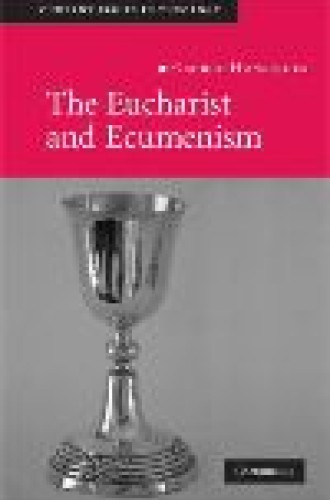The Eucharist and Ecumenism: Let Us Keep the Feast
We Christians are a people divided by what unites us. We believe that God has, through the body and blood of Jesus Christ, made us one people, but how the Eucharist works to make us one with God and one another has been one of the most divisive points of conflict between Christians, particularly since the Reformation. Over time the sides have hardened, leading many to assume that the differences are intractable and that therefore it is best not to bring them up. As a result, questions about Christ’s presence in the elements, the sacrificial character of the meal, the status of the celebrant and the social and political implications of the Eucharist are increasingly assumed to be theological side issues that are irrelevant for the challenges facing the contemporary church.
So thank God for George Hunsinger. He refuses to let past polemics die. In this elegantly written and well-argued book he addresses each of the areas of contention with clarity and generosity in the hope that we can rediscover the unity that is ours.
Before addressing the points of contention, he provides a quite interesting typology of contemporary theology. “Enclave theology” is theology determined by a single tradition in which there is little interest in other traditions except when it comes to defeating or withstanding them. In contrast, “ecumenical theology” presumes that every tradition in the church has something valuable to contribute, though we may not be able to discern at present what that may be. Ecumenical theology does not assume that we can make traditions agree by forcing artificial agreements, but rather seeks deeper unity in which all traditions are faithful to Christ. In contrast to both of these, “academic theology” has no allegiance to any traditions or to norms such as those established in the creeds.
Though these types can and often do overlap, Hunsinger clearly is determined to be an ecumenical theologian. Moreover, he is quite candid about the fact that he is one in the Reformed tradition. He has obviously been deeply influenced by Barth and by T. F. Torrance. Still, his constructive proposals also draw on Orthodox, Jewish and Anabaptist sources. His ability to understand and use other traditions reveals not only his lightly carried erudition but the generous orthodoxy that shapes this work.
The Eucharist and Ecumenism is organized around the four nodes of controversy—presence, sacrifice, priesthood and social significance. In his discussion of each of these issues he deftly identifies the central issue and the positions assumed to be in conflict, then suggests a way forward that can move us beyond the disagreements.
He begins his discussion of real presence, for example, with Aquinas’s successful attempt to sustain the necessary claim that Christ’s body is “locally present” in heaven in a manner that makes possible Christ’s substantial presence in the bread and wine. Hunsinger makes the extremely important point that Aquinas could conclude that Christ’s presence is in the bread and wine in such a way that Christ is no less present in heaven because he considered the transubstantiation of the bread and the wine to be analogous to creation ex nihilo. Luther, on the other hand, emphasized Christ’s local presence in the Eucharist by drawing on an analogy with the incarnation—that is, he believed that Christ is present in the Eucharist just as divine nature dwelt bodily in Christ. Calvin’s contribution was to suggest that through the work of the Holy Spirit the bread and wine were elevated to become the body and blood of Christ. Hunsinger provides a sympathetic account of Luther and Calvin but thinks neither provided an account quite as satisfying as Aquinas’s.
I am very sympathetic with Hunsinger’s sympathetic account of Aquinas, but I wish he had discussed P. J. FitzPatrick’s critique of Aquinas in the book In Breaking of Bread: The Eucharist and Ritual. FitzPatrick, a Roman Catholic philosopher, is well aware that Aquinas said that transubstantiation resembles creation, but he argues that Aquinas’s account of transubstantiation mistakenly confuses the predicate “being bread” with “being Christ.”
Hunsinger draws on the work of Peter Martyr Vermigli, a contemporary of Calvin whom he describes as an unjustly neglected Reformed theologian, to craft a fascinating proposal that he hopes will satisfy all sides. Vermigli retained Calvin’s focus on the Holy Spirit, and he “upgraded” Luther’s incarnational analogy by suggesting that the elements are not so much a “means of grace” but rather “instruments of the Spirit”; this makes possible, as Aquinas emphasized, our participation in Christ’s whole life. Vermigli drew on the Orthodox idea that just as iron is transformed by its participation in a fire, so the sacramental elements are transformed by a sacramental union. Vermigli learned from the 11th-century Orthodox archbishop of Bulgaria, Theophylact, to use “the carefully chosen but inelegant word” transelementation to describe the sacramental union of the bread and wine with Christ’s flesh.
By clarifying and then underwriting Vermigli’s understanding of the Eucharist, Hunsinger hopes to move non-Catholics closer to the Eastern Orthodox and even to Roman Catholics. That the Orthodox views on these matters are not unacceptable to Roman Catholics makes possible an unanticipated convergence. Just as important, Hunsinger shows, this view of the action of the Eucharist does justice to what most traditions say in the eucharistic prayer. He never loses sight of the fact that these issues are not just about theory but about what Christians do liturgically.
Turning to questions surrounding the eucharistic sacrifice, Hunsinger begins with Luther’s and Calvin’s concern that the Eucharist not become a sacrifice in addition to the one Christ offered on the cross. Hunsinger has little difficulty in showing that Aquinas was in full agreement with Luther and Calvin on this, but notes that Aquinas was never entirely clear about how Christ’s unique sacrifice was one with the Eucharist while still being distinguished from it. Hunsinger suggests this can be explained by analogy with the Jewish Passover, in which the memorial and sacrifice were one. In like manner, those who receive Christ become participants through anamnesis in the one true sacrifice. Those receiving Christ’s body and blood are made one with his perfect sacrifice of love. Christ’s sacrifice is, therefore, not repeated but re-presented through the epiclesis, which brings the past and future into the present.
In a lovely “Liturgical postlude” to his account of sacrifice, Hunsinger calls attention to Protestant prayers and hymns that incorporate the theme of eucharistic sacrifice as he has displayed it through analogy with the Passover. He does so in order to suggest that the Reformed tradition has incorporated the language of sacrifice into its liturgies in a manner that Catholics can recognize as consistent with their view of the mass.
Hunsinger begins his account of eucharistic ministry with an exploration of what the Catholic description of the Protestant ministry as defectus might mean. He does not avoid the most negative reading, which entails that the one church subsists only in the Catholic Church. Hunsinger notes that Cardinal Walter Kasper has made statements suggesting a less negative appraisal of the Protestant ministry, but it is clear that on this issue he is less sure about how to proceed than in his discussions of presence and sacrifice. He does, however, provide “questions of ecumenical admonition” that should set an agenda for future conversations.
In the fourth section of the book, Hunsinger develops an account of the Eucharist and social ethics. This section is not clearly driven by the ecumenical problematic that shapes the first three sections of the book. Here Hunsinger develops an account of the Eucharist and the transformation of culture by engaging critically with H. Richard Niebuhr’s Christ and Culture. He finds Niebuhr’s account useful even though he accepts most of John Howard Yoder’s criticisms of the theological presumptions that shaped Niebuhr’s typology. He is, for example, well aware that Niebuhr’s understanding of the Trinity is modalist, yet he still thinks that Niebuhr provides a way to understand the eucharistic community as countercultural in a way that does not exclude intervention in the cultures in which it finds itself.
Hunsinger’s chapter on Nicene Christianity, the Eucharist and peace is a wonderful conclusion to the book. Here he argues, against some Anabaptist theologians, that the Nicene Creed is both essential for the eucharistic ethos and crucial for the peace witness of the ecumenical church. He argues that Athanasius rightly saw an essential connection between the incarnation and renunciation of warfare, and he provides a wonderful account of Anselm’s understanding of the atonement as an alternative to violence. Hunsinger ends this chapter by calling attention to Dale Aukerman’s extraordinary book Dark ening Valley: A Biblical Perspective on Nuclear War, an author and book I have long admired for making the necessary connection between an ethic of nonviolence and a high view of the incarnation.
Though it is not clear how this part of the book is driven by Hunsinger’s ecumenical agenda, it is the most important for ecumenical relations. Surely it would be of major ecumenical significance for Christians to understand that they belie what they do in the Eucharist when they entertain the possibility of killing anyone—and in particular those with whom they share the body and blood of Christ. I would have found it fascinating if Hunsinger had explored the implications of this part of his analysis for non-eucharistic churches.
The Eucharist and Ecumenism is a book that someone needed to write, but it was not clear that anyone would know how to write it. Hunsinger has shown us that it can be done. We owe it to him and one another to take up the proposals for future conversations that he outlines so clearly in his conclusion. For if we do not hunger and thirst for the unity of the body of Christ, then we face a real question as to whether we should continue to keep the feast.






